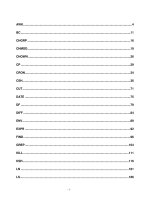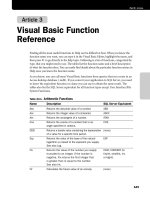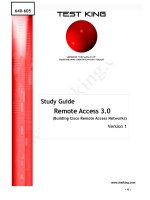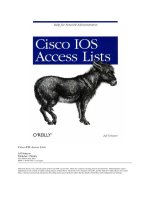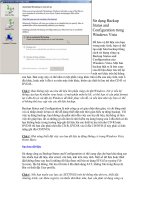Cisco IOS Configuration Fundamentals Command Reference ppt
Bạn đang xem bản rút gọn của tài liệu. Xem và tải ngay bản đầy đủ của tài liệu tại đây (7.22 MB, 1,244 trang )
Americas Headquarters
Cisco Systems, Inc.
170 West Tasman Drive
San Jose, CA 95134-1706
USA
Tel: 408 526-4000
800 553-NETS (6387)
Fax: 408 527-0883
Cisco IOS Configuration Fundamentals
Command Reference
April 2010
Text Part Number:
THE SPECIFICATIONS AND INFORMATION REGARDING THE PRODUCTS IN THIS MANUAL ARE SUBJECT TO CHANGE WITHOUT NOTICE. ALL
STATEMENTS, INFORMATION, AND RECOMMENDATIONS IN THIS MANUAL ARE BELIEVED TO BE ACCURATE BUT ARE PRESENTED WITHOUT
WARRANTY OF ANY KIND, EXPRESS OR IMPLIED. USERS MUST TAKE FULL RESPONSIBILITY FOR THEIR APPLICATION OF ANY PRODUCTS.
THE SOFTWARE LICENSE AND LIMITED WARRANTY FOR THE ACCOMPANYING PRODUCT ARE SET FORTH IN THE INFORMATION PACKET THAT
SHIPPED WITH THE PRODUCT AND ARE INCORPORATED HEREIN BY THIS REFERENCE. IF YOU ARE UNABLE TO LOCATE THE SOFTWARE LICENSE
OR LIMITED WARRANTY, CONTACT YOUR CISCO REPRESENTATIVE FOR A COPY.
The Cisco implementation of TCP header compression is an adaptation of a program developed by the University of California, Berkeley (UCB) as part of UCB’s public
domain version of the UNIX operating system. All rights reserved. Copyright © 1981, Regents of the University of California.
NOTWITHSTANDING ANY OTHER WARRANTY HEREIN, ALL DOCUMENT FILES AND SOFTWARE OF THESE SUPPLIERS ARE PROVIDED “AS IS” WITH
ALL FAULTS. CISCO AND THE ABOVE-NAMED SUPPLIERS DISCLAIM ALL WARRANTIES, EXPRESSED OR
IMPLIED, INCLUDING, WITHOUT
LIMITATION, THOSE OF MERCHANTABILITY, FITNESS FOR A PARTICULAR PURPOSE AND NONINFRINGEMENT OR ARISING FROM A COURSE OF
DEALING, USAGE, OR TRADE PRACTICE.
IN NO EVENT SHALL CISCO OR ITS SUPPLIERS BE LIABLE FOR ANY INDIRECT, SPECIAL, CONSEQUENTIAL, OR INCIDENTAL DAMAGES, INCLUDING,
WITHOUT LIMITATION, LOST PROFITS OR LOSS OR DAMAGE TO DATA ARISING OUT OF THE USE OR INABILITY TO USE THIS MANUAL, EVEN IF CISCO
OR ITS SUPPLIERS HAVE BEEN ADVISED OF THE POSSIBILITY OF SUCH DAMAGES.
CCDE, CCENT, CCSI, Cisco Eos, Cisco Explorer, Cisco HealthPresence, Cisco IronPort, the Cisco logo, Cisco Nurse Connect, Cisco Pulse, Cisco SensorBase,
Cisco
StackPower, Cisco StadiumVision, Cisco TelePresence, Cisco TrustSec, Cisco Unified Computing System, Cisco WebEx, DCE, Flip Channels, Flip for Good, Flip
Mino, Flipshare (Design), Flip Ultra, Flip Video, Flip Video (Design), Instant Broadband, and Welcome to the Human Network are trademarks; Changing the Way We Work,
Live, Play, and Learn, Cisco
Capital, Cisco Capital (Design), Cisco:Financed (Stylized), Cisco Store, Flip Gift Card, and One Million Acts of Green are service marks; and
Access Registrar, Aironet, AllTouch, AsyncOS, Bringing the Meeting To You, Catalyst, CCDA, CCDP, CCIE, CCIP, CCNA, CCNP, CCSP, CCVP, Cisco, the
Cisco
Certified Internetwork Expert logo, Cisco IOS, Cisco Lumin, Cisco Nexus, Cisco Press, Cisco Systems, Cisco Systems Capital, the Cisco Systems logo, Cisco Unity,
Collaboration Without Limitation, Continuum, EtherFast, EtherSwitch, Event Center, Explorer, Follow Me Browsing, GainMaker, iLYNX, IOS, iPhone, IronPort, the
IronPort logo, Laser Link, LightStream, Linksys, MeetingPlace, MeetingPlace Chime Sound, MGX, Networkers, Networking Academy, PCNow, PIX, PowerKEY,
PowerPanels, PowerTV, PowerTV (Design), PowerVu, Prisma, ProConnect, ROSA, SenderBase, SMARTnet, Spectrum Expert, StackWise, WebEx, and the WebEx logo are
registered trademarks of Cisco and/or its affiliates in the United States and certain other countries.
All other trademarks mentioned in this document or website are the property of their respective owners. The use of the word partner does not imply a partnership relationship
between Cisco and any other company. (1002R)
Any Internet Protocol (IP) addresses used in this document are not intended to be actual addresses. Any examples, command display output, and figures included in the
document are shown for illustrative purposes only. Any use of actual IP addresses in illustrative content is unintentional and coincidental.
Cisco IOS Configuration Fundamentals Command Reference
© 2010 Cisco Systems, Inc. All rights reserved.
iii
Cisco IOS Configuration Fundamentals Command Reference
April 2010
CONTENTS
About Cisco IOS Software Documentation xxi
Documentation Objectives xxi
Audience xxi
Documentation Conventions xxi
Typographic Conventions xxii
Command Syntax Conventions xxii
Software Conventions xxiii
Reader Alert Conventions xxiii
Documentation Organization xxiii
Cisco IOS Documentation Set xxiv
Cisco IOS Documentation on Cisco.com xxiv
Configuration Guides, Command References, and Supplementary Resources xxv
Additional Resources and Documentation Feedback xxxi
Using the Command-Line Interface in Cisco IOS Software xxxiii
Initially Configuring a Device xxxiii
Using the CLI xxxiv
Understanding Command Modes xxxiv
Using the Interactive Help Feature xxxvii
Understanding Command Syntax xxxviii
Understanding Enable and Enable Secret Passwords xxxix
Using the Command History Feature xl
Abbreviating Commands xli
Using Aliases for CLI Commands xli
Using the no and default Forms of Commands xlii
Using the debug Command xlii
Filtering Output Using Output Modifiers xlii
Understanding CLI Error Messages xliii
Saving Changes to a Configuration xliv
Additional Information xliv
Introduction CF-1
Cisco IOS IFS Command Syntax CF-2
Obtaining Documentation, Obtaining Support, and Security Guidelines CF-3
Contents
iv
Cisco IOS Configuration Fundamentals Command Reference
April 2010
Configuration Fundamentals Commands CF-5
activation-character CF-6
alias CF-7
archive CF-11
archive config CF-12
archive log config persistent save CF-14
archive tar CF-15
async-bootp CF-18
attach CF-20
autobaud CF-23
auto-sync CF-24
autoupgrade disk-cleanup CF-26
autoupgrade ida url CF-27
autoupgrade status email CF-28
banner exec CF-29
banner incoming CF-31
banner login CF-33
banner motd CF-35
banner slip-ppp CF-37
boot CF-39
boot bootldr CF-43
boot bootstrap CF-45
boot config CF-47
boot host CF-50
boot network CF-53
boot system CF-56
boot-end-marker CF-62
boot-start-marker CF-64
cd CF-66
clear archive log config CF-68
clear catalyst6000 traffic-meter CF-69
clear configuration lock CF-70
clear ip http client cache CF-72
clear logging CF-73
clear logging system CF-74
Contents
v
Cisco IOS Configuration Fundamentals Command Reference
April 2010
clear logging xml CF-76
clear mls statistics CF-77
clear parser cache CF-78
clear platform netint CF-79
clear processes interrupt mask CF-80
clear tcp CF-81
clear vlan counters CF-83
clock CF-84
clock initialize nvram CF-86
config-register CF-87
configuration mode exclusive CF-89
configure confirm CF-95
configure memory CF-97
configure network CF-99
configure overwrite-network CF-100
configure replace CF-101
configure revert CF-105
configure terminal CF-107
confreg CF-109
continue (ROM monitor) CF-111
copy CF-112
copy erase flash CF-130
copy http:// CF-131
copy https:// CF-132
copy logging system CF-133
copy xmodem: CF-135
copy ymodem: CF-136
copy /noverify CF-137
databits CF-141
data-character-bits CF-143
default-value exec-character-bits CF-144
default-value special-character-bits CF-145
define interface-range CF-146
delete CF-148
diag CF-150
Contents
vi
Cisco IOS Configuration Fundamentals Command Reference
April 2010
diagnostic bootup level CF-153
diagnostic cns CF-155
diagnostic event-log size CF-157
diagnostic level CF-158
diagnostic monitor CF-160
diagnostic ondemand CF-164
diagnostic schedule test CF-166
diagnostic start CF-169
diagnostic stop CF-173
dir CF-175
disable CF-177
disconnect-character CF-178
dispatch-character CF-179
dispatch-machine CF-181
dispatch-timeout CF-183
do CF-185
downward-compatible-config CF-187
editing CF-188
enable CF-191
end CF-194
environment-monitor shutdown temperature CF-195
environment temperature-controlled CF-196
erase CF-197
erase bootflash CF-200
errdisable detect cause CF-201
errdisable recovery CF-203
escape-character CF-205
exec CF-207
exec-banner CF-208
exec-character-bits CF-210
exec-timeout CF-212
execute-on CF-213
exit (EXEC) CF-216
exit (global) CF-217
file prompt CF-218
Contents
vii
Cisco IOS Configuration Fundamentals Command Reference
April 2010
file verify auto CF-219
format CF-221
fsck CF-225
full-help CF-231
help CF-233
hidekeys CF-235
history CF-237
history size CF-239
hold-character CF-240
hostname CF-241
hw-module reset CF-243
hw-module shutdown CF-244
insecure CF-245
international CF-246
ip bootp server CF-247
ip finger CF-249
ip ftp passive CF-251
ip ftp password CF-252
ip ftp source-interface CF-253
ip ftp username CF-255
ip rarp-server CF-256
ip rcmd domain-lookup CF-258
ip rcmd rcp-enable CF-260
ip rcmd remote-host CF-261
ip rcmd remote-username CF-264
ip rcmd rsh-enable CF-266
ip rcmd source-interface CF-267
ip telnet source-interface CF-269
ip tftp source-interface CF-270
ip wccp web-cache accelerated CF-272
length CF-274
load-interval CF-275
location CF-277
lock CF-278
lockable CF-280
Contents
viii
Cisco IOS Configuration Fundamentals Command Reference
April 2010
log config CF-281
logging enable CF-282
logging event bundle-status CF-283
logging event link-status (global configuration) CF-285
logging event link-status (interface configuration) CF-287
logging event subif-link-status CF-289
logging event trunk-status CF-291
logging ip access-list cache (global configuration) CF-292
logging ip access-list cache (interface configuration) CF-294
logging persistent (config-archive-log-cfg) CF-296
logging persistent reload (config-archive-log-cfg) CF-298
logging size CF-299
logging synchronous CF-301
logging system CF-304
logout CF-305
logout-warning CF-306
macro (global configuration) CF-307
macro (interface configuration) CF-309
maximum CF-311
memory free low-watermark CF-313
memory lite CF-315
memory reserve critical CF-316
memory sanity CF-318
memory scan CF-319
memory-size iomem CF-320
menu (EXEC) CF-322
menu <menu-name> single-space CF-324
menu clear-screen CF-325
menu command CF-327
menu default CF-329
menu line-mode CF-330
menu options CF-332
menu prompt CF-333
menu status-line CF-334
menu text CF-335
Contents
ix
Cisco IOS Configuration Fundamentals Command Reference
April 2010
menu title CF-337
microcode (12000) CF-339
microcode (7000/7500) CF-341
microcode (7200) CF-343
microcode reload (12000) CF-345
microcode reload (7000/7500) CF-347
microcode reload (7200) CF-348
mkdir CF-349
mkdir disk0: CF-351
mode CF-352
CF-355
monitor event-trace (EXEC) CF-356
monitor event-trace (global) CF-359
monitor event-trace dump-traces CF-362
monitor permit-list CF-363
monitor session egress replication-mode CF-365
monitor session type CF-367
mop device-code CF-375
mop retransmit-timer CF-376
mop retries CF-377
more CF-378
more <url> begin CF-381
more <url> exclude CF-383
more <url> include CF-385
more flh:logfile CF-387
motd-banner CF-389
name-connection CF-391
no menu CF-392
notify CF-393
notify syslog CF-394
padding CF-396
parity CF-397
parser cache CF-399
parser command serializer CF-400
parser config cache interface CF-401
Contents
x
Cisco IOS Configuration Fundamentals Command Reference
April 2010
parser config partition CF-403
partition CF-405
path (archive configuration) CF-407
periodic CF-411
ping CF-414
ping (privileged) CF-418
ping ip CF-421
ping vrf CF-425
platform shell CF-428
power enable CF-429
power redundancy-mode CF-430
printer CF-431
private CF-433
privilege CF-434
process cpu statistics limit entry-percentage CF-439
process cpu threshold type CF-440
process-max-time CF-442
prompt CF-443
pwd CF-445
refuse-message CF-446
reload CF-447
remote command CF-451
remote login CF-453
remote-span CF-455
rename CF-456
request platform software package describe file CF-457
request platform software package expand file CF-463
request platform software package install commit CF-466
request platform software package install file CF-468
request platform software package install rollback CF-477
request platform software package install snapshot CF-479
request platform software process release CF-481
request platform software system shell CF-483
request platform software shell session output format CF-484
request platform software vty attach CF-487
Contents
xi
Cisco IOS Configuration Fundamentals Command Reference
April 2010
revision CF-488
rmdir CF-490
rommon-pref CF-492
route-converge-interval CF-494
rsh CF-496
scheduler allocate CF-498
scheduler heapcheck process CF-500
scheduler interrupt mask profile CF-502
scheduler interrupt mask size CF-503
scheduler interrupt mask time CF-504
scheduler interval CF-505
send CF-506
service compress-config CF-508
service config CF-510
service counters max age CF-512
service decimal-tty CF-514
service exec-wait CF-515
service finger CF-516
service hide-telnet-address CF-517
service linenumber CF-518
service nagle CF-520
service prompt config CF-521
service sequence-numbers CF-522
service slave-log CF-523
service tcp-keepalives-in CF-524
service tcp-keepalives-out CF-525
service tcp-small-servers CF-526
service telnet-zero-idle CF-527
service timestamps CF-528
service udp-small-servers CF-533
service-module apa traffic-management CF-534
service-module wlan-ap bootimage CF-536
service-module wlan-ap reload CF-538
service-module wlan-ap reset CF-540
service-module wlan-ap session CF-542
Contents
xii
Cisco IOS Configuration Fundamentals Command Reference
April 2010
service-module wlan-ap statistics CF-544
service-module wlan-ap status CF-545
session slot CF-546
set memory debug incremental starting-time CF-547
setup CF-548
show CF-555
show <command> append CF-557
show <command> begin CF-558
show <command> exclude CF-560
show <command> include CF-562
show <command> redirect CF-564
show <command> section CF-565
show <command> tee CF-567
show (Flash file system) CF-569
show aliases CF-578
show alignment CF-579
show archive CF-582
show archive config differences CF-584
show archive config incremental-diffs CF-587
show archive config rollback timer CF-589
show archive log config CF-591
show async bootp CF-595
show autoupgrade configuration unknown CF-596
show bootflash: CF-598
show bootvar CF-600
show buffers CF-603
show buffers summary CF-609
show c2600 CF-611
show c7200 CF-614
show catalyst6000 CF-615
show cls CF-617
show config id CF-619
show configuration lock CF-621
show context CF-625
show controllers (GRP image) CF-628
Contents
xiii
Cisco IOS Configuration Fundamentals Command Reference
April 2010
show controllers (line card image) CF-630
show controllers logging CF-638
show controllers tech-support CF-640
show coverage history CF-642
show data-corruption CF-643
show debugging CF-644
show declassify CF-646
show derived-config CF-648
show diagnostic cns CF-651
show diagnostic sanity CF-652
show disk CF-657
show disk0: CF-659
show disk1: CF-662
show environment CF-665
show environment alarm CF-691
show environment cooling CF-694
show environment status CF-695
show environment temperature CF-698
show errdisable detect CF-701
show errdisable recovery CF-702
show fastblk CF-703
show file descriptors CF-705
show file information CF-706
show file systems CF-708
show flh-log CF-710
show fm inspect CF-711
show fm interface CF-713
show fm reflexive CF-716
show fm summary CF-717
show funi CF-718
show identity policy CF-722
show identity profile CF-723
show gsr CF-724
show gt64010 (7200) CF-725
show hardware CF-727
Contents
xiv
Cisco IOS Configuration Fundamentals Command Reference
April 2010
show health-monitor CF-729
show history CF-730
show history all CF-732
show hosts CF-735
show html CF-738
show idb CF-740
show idprom CF-741
show inventory CF-747
show logging CF-750
show logging count CF-756
show logging history CF-758
show logging system CF-760
show logging xml CF-763
show memory CF-765
show memory allocating-process CF-770
show memory dead CF-773
show memory debug incremental CF-775
show memory debug leaks CF-778
show memory debug references CF-783
show memory debug unused CF-785
show memory ecc CF-787
show memory events CF-789
show memory failures alloc CF-791
show memory fast CF-792
show memory fragment CF-795
show memory multibus CF-798
show memory pci CF-800
show memory processor CF-802
show memory scan CF-806
show memory statistics history table CF-808
show memory traceback CF-811
show memory transient CF-813
show microcode CF-815
show mls statistics CF-817
show module CF-820
Contents
xv
Cisco IOS Configuration Fundamentals Command Reference
April 2010
show monitor event-trace CF-823
CF-829
show monitor permit-list CF-830
show monitor session CF-831
show msfc CF-836
show pagp CF-840
show parser dump CF-842
show parser macro CF-854
show parser statistics CF-856
show pci CF-859
show pci hardware CF-861
show perf-meas CF-863
show platform CF-865
show platform bridge CF-876
show platform cfm CF-878
show platform diag CF-880
show platform hardware capacity CF-883
show platform isg CF-890
show platform oam CF-891
show platform redundancy CF-892
show platform software filesystem CF-894
show platform software memory CF-897
show platform software mount CF-903
show platform software process list CF-907
show platform software tech-support CF-914
show platform supervisor CF-916
show power CF-917
show processes CF-921
show processes cpu CF-928
show processes interrupt mask buffer CF-936
show processes interrupt mask detail CF-938
show processes memory CF-940
CF-950
show protocols CF-951
show region CF-954
Contents
xvi
Cisco IOS Configuration Fundamentals Command Reference
April 2010
show registry CF-957
show reload CF-960
show resource-pool queue CF-961
show rom-monitor CF-963
show rom-monitor slot CF-966
show running identity policy CF-968
show running identity profile CF-969
show running-config CF-970
show running-config control-plane CF-976
show running-config map-class CF-977
show running-config partition CF-980
show scp CF-983
show slot CF-985
show slot0: CF-988
show slot1: CF-991
show software authenticity file CF-994
show software authenticity keys CF-996
show software authenticity running CF-998
show software authenticity upgrade-status CF-1000
show stacks CF-1002
show startup-config CF-1004
show subsys CF-1005
show sup-bootflash CF-1007
show sysctrl CF-1010
show system jumbomtu CF-1013
show tech-support CF-1014
show template CF-1021
show usb controllers CF-1022
show usb device CF-1024
show usb driver CF-1027
show usb port CF-1029
show usb tree CF-1030
show usbtoken CF-1031
show version CF-1033
show warm-reboot CF-1052
Contents
xvii
Cisco IOS Configuration Fundamentals Command Reference
April 2010
show whoami CF-1053
showmon CF-1054
slave auto-sync config CF-1056
slave default-slot CF-1058
slave image CF-1060
slave reload CF-1062
slave sync config CF-1063
slave terminal CF-1065
special-character-bits CF-1066
squeeze CF-1067
stack-mib portname CF-1070
state-machine CF-1071
stopbits CF-1073
storm-control level CF-1074
sync-restart-delay CF-1076
system flowcontrol bus CF-1077
system jumbomtu CF-1078
tdm clock priority CF-1080
terminal databits CF-1082
terminal data-character-bits CF-1083
terminal dispatch-character CF-1084
terminal dispatch-timeout CF-1085
terminal download CF-1086
terminal editing CF-1087
terminal escape-character CF-1088
terminal exec-character-bits CF-1089
terminal flowcontrol CF-1090
terminal full-help CF-1091
terminal history CF-1093
terminal history size CF-1095
terminal hold-character CF-1097
terminal international CF-1099
terminal keymap-type CF-1100
terminal length CF-1101
terminal monitor CF-1102
Contents
xviii
Cisco IOS Configuration Fundamentals Command Reference
April 2010
terminal notify CF-1103
terminal padding CF-1104
terminal parity CF-1105
terminal rxspeed CF-1106
terminal special-character-bits CF-1107
terminal speed CF-1109
terminal start-character CF-1110
terminal stopbits CF-1111
terminal stop-character CF-1112
terminal telnet break-on-ip CF-1113
terminal telnet refuse-negotiations CF-1114
terminal telnet speed CF-1115
terminal telnet sync-on-break CF-1116
terminal telnet transparent CF-1117
terminal terminal-type CF-1118
terminal txspeed CF-1119
terminal width CF-1120
terminal-queue entry-retry-interval CF-1121
terminal-type CF-1122
test cable-diagnostics CF-1123
test flash CF-1125
test interfaces CF-1126
test memory CF-1127
test memory destroy CF-1128
test platform police get CF-1129
test platform police set CF-1130
tftp-server CF-1132
tftp-server system CF-1135
time-period CF-1136
trace (privileged) CF-1138
trace (user) CF-1142
traceroute CF-1145
traceroute mac CF-1148
undelete CF-1152
upgrade automatic abortversion CF-1154
Contents
xix
Cisco IOS Configuration Fundamentals Command Reference
April 2010
upgrade automatic getversion CF-1156
upgrade automatic runversion CF-1159
upgrade filesystem monlib CF-1161
upgrade rom-monitor CF-1162
upgrade rom-monitor file CF-1167
upgrade rom-monitor preference CF-1171
vacant-message CF-1172
verify CF-1174
vtp CF-1179
warm-reboot CF-1182
where CF-1184
width CF-1185
write core CF-1186
write erase CF-1188
write memory CF-1189
write terminal CF-1190
xmodem CF-1191
ASCII Character Set and Hexadecimal Values CF-1193
Contents
xx
Cisco IOS Configuration Fundamentals Command Reference
April 2010
xxi
Cisco IOS Configuration Fundamentals Command Reference
April 2010
About Cisco IOS Software Documentation
Last Updated: March 26, 2010
This document describes the objectives, audience, conventions, and organization used in Cisco IOS
software documentation. Also included are resources for obtaining technical assistance, additional
documentation, and other information from Cisco. This document is organized into the following
sections:
• Documentation Objectives, page xxi
• Audience, page xxi
• Documentation Conventions, page xxi
• Documentation Organization, page xxiii
• Additional Resources and Documentation Feedback, page xxxi
Documentation Objectives
Cisco IOS documentation describes the tasks and commands available to configure and maintain Cisco
networking devices.
Audience
The Cisco IOS documentation set is intended for users who configure and maintain Cisco networking
devices (such as routers and switches) but who may not be familiar with the configuration and
maintenance tasks, the relationship among tasks, or the Cisco IOS commands necessary to perform
particular tasks. The Cisco IOS documentation set is also intended for those users experienced with
Cisco IOS software who need to know about new features, new configuration options, and new software
characteristics in the current Cisco IOS release.
Documentation Conventions
In Cisco IOS documentation, the term router may be used to refer to various Cisco products; for example,
routers, access servers, and switches. These and other networking devices that support Cisco
IOS
software are shown interchangeably in examples and are used only for illustrative purposes. An example
that shows one product does not necessarily mean that other products are not supported.
About Cisco IOS Software Documentation
Documentation Conventions
xxii
Cisco IOS Configuration Fundamentals Command Reference
April 2010
This section contains the following topics:
• Typographic Conventions, page xxii
• Command Syntax Conventions, page xxii
• Software Conventions, page xxiii
• Reader Alert Conventions, page xxiii
Typographic Conventions
Cisco IOS documentation uses the following typographic conventions:
Command Syntax Conventions
Cisco IOS documentation uses the following command syntax conventions:
Convention Description
^ or Ctrl Both the ^ symbol and Ctrl represent the Control (Ctrl) key on a keyboard. For
example, the key combination ^D or Ctrl-D means that you hold down the
Control key while you press the D key. (Keys are indicated in capital letters but
are not case
sensitive.)
string A string is a nonquoted set of characters shown in italics. For example, when
setting a Simple Network Management Protocol (SNMP) community string to
public, do not use quotation marks around the string; otherwise, the string will
include the quotation marks.
Convention Description
bold Bold text indicates commands and keywords that you enter as shown.
italic Italic text indicates arguments for which you supply values.
[x] Square brackets enclose an optional keyword or argument.
An ellipsis (three consecutive nonbolded periods without spaces) after a syntax
element indicates that the element can be repeated.
| A vertical line, called a pipe, that is enclosed within braces or square brackets
indicates a choice within a set of keywords or
arguments.
[x | y] Square brackets enclosing keywords or arguments separated by a pipe indicate
an optional choice.
{x | y} Braces enclosing keywords or arguments separated by a pipe indicate a
required
choice.
[x {y | z}] Braces and a pipe within square brackets indicate a required choice within an
optional element.
About Cisco IOS Software Documentation
Documentation Organization
xxiii
Cisco IOS Configuration Fundamentals Command Reference
April 2010
Software Conventions
Cisco IOS software uses the following program code conventions:
Reader Alert Conventions
Cisco IOS documentation uses the following conventions for reader alerts:
Caution Means reader be careful. In this situation, you might do something that could result in equipment
damage or loss of data.
Note Means reader take note. Notes contain helpful suggestions or references to material not covered in the
manual.
Timesaver Means the described action saves time. You can save time by performing the action described in the
paragraph.
Documentation Organization
This section describes the Cisco IOS documentation set, how it is organized, and how to access it on
Cisco.com. It also lists the configuration guides, command references, and supplementary references
and resources that comprise the documentation set. It contains the following topics:
• Cisco IOS Documentation Set, page xxiv
• Cisco IOS Documentation on Cisco.com, page xxiv
• Configuration Guides, Command References, and Supplementary Resources, page xxv
Convention Description
Courier font
Courier font is used for information that is displayed on a PC or terminal screen.
Bold Courier font
Bold Courier font indicates text that the user must enter.
< > Angle brackets enclose text that is not displayed, such as a password. Angle
brackets also are used in contexts in which the italic font style is not supported;
for example, ASCII text.
! An exclamation point at the beginning of a line indicates that the text that follows
is a comment, not a line of code. An exclamation point is also displayed by
Cisco
IOS software for certain processes.
[ ] Square brackets enclose default responses to system prompts.
About Cisco IOS Software Documentation
Documentation Organization
xxiv
Cisco IOS Configuration Fundamentals Command Reference
April 2010
Cisco IOS Documentation Set
The Cisco IOS documentation set consists of the following:
• Release notes and caveats provide information about platform, technology, and feature support for
a release and describe severity 1 (catastrophic), severity 2 (severe), and select severity 3 (moderate)
defects in released Cisco IOS software. Review release notes before other documents to learn
whether updates have been made to a feature.
• Sets of configuration guides and command references organized by technology and published for
each standard Cisco IOS release.
–
Configuration guides—Compilations of documents that provide conceptual and task-oriented
descriptions of Cisco IOS features.
–
Command references—Compilations of command pages in alphabetical order that provide
detailed information about the commands used in the Cisco IOS features and the processes that
comprise the related configuration guides. For each technology, there is a single command
reference that supports all Cisco IOS releases and that is updated at each standard release.
• Lists of all the commands in a specific release and all commands that are new, modified, removed,
or replaced in the release.
• Command reference book for debug commands. Command pages are listed in alphabetical order.
• Reference book for system messages for all Cisco IOS releases.
Cisco IOS Documentation on Cisco.com
The following sections describe the organization of the Cisco IOS documentation set and how to access
various document types.
Use Cisco Feature Navigator to find information about platform support and Cisco IOS and Catalyst OS
software image support. To access Cisco Feature Navigator, go to
An
account on Cisco.com is not required.
Feature Guides
Cisco IOS features are documented in feature guides. Feature guides describe one feature or a group of
related features that are supported on many different software releases and platforms. Your Cisco
IOS
software release or platform may not support all the features documented in a feature guide. See the
Feature Information table at the end of the feature guide for information about which features in that
guide are supported in your software release.
Configuration Guides
Configuration guides are provided by technology and release and comprise a set of individual feature
guides relevant to the release and technology.
Command References
Command reference books contain descriptions of Cisco IOS commands that are supported in many
different software releases and on many different platforms. The books are organized by technology. For
information about all Cisco IOS commands, use the Command Lookup Tool at
or the Cisco IOS Master Command List, All Releases, at
About Cisco IOS Software Documentation
Documentation Organization
xxv
Cisco IOS Configuration Fundamentals Command Reference
April 2010
Cisco IOS Supplementary Documents and Resources
Supplementary documents and resources are listed in Table 2 on page xxxi.
Configuration Guides, Command References, and Supplementary Resources
Table 1 lists, in alphabetical order, Cisco IOS software configuration guides and command references,
including brief descriptions of the contents of the documents. The Cisco IOS command references
contain commands for Cisco
IOS software for all releases. The configuration guides and command
references support many different software releases and platforms. Your Cisco
IOS software release or
platform may not support all these technologies.
Table 2 lists documents and resources that supplement the Cisco IOS software configuration guides and
command references. These supplementary resources include release notes and caveats; master
command lists; new, modified, removed, and replaced command lists; system messages; and the debug
command reference.
For additional information about configuring and operating specific networking devices, and to access
Cisco
IOS documentation, go to the Product/Technologies Support area of Cisco.com at the following
location:
Ta ble 1 Cisco IOS Configuration Guides and Command References
Configuration Guide and Command Reference Titles Features/Protocols/Technologies
• Cisco IOS AppleTalk Configuration Guide
• Cisco IOS AppleTalk Command Reference
AppleTalk protocol.
• Cisco IOS Asynchronous Transfer Mode
Configuration
Guide
• Cisco IOS Asynchronous Transfer Mode
Command
Reference
LAN ATM, multiprotocol over ATM (MPoA), and WAN ATM.
• Cisco IOS Bridging and IBM Networking
Configuration
Guide
• Cisco IOS Bridging Command Reference
• Cisco IOS IBM Networking Command Reference
Transparent and source-route transparent (SRT) bridging,
source-route bridging (SRB), Token Ring Inter-Switch Link
(TRISL), and token ring route switch module (TRRSM).
Data-link switching plus (DLSw+), serial tunnel (STUN), block
serial tunnel (BSTUN); logical link control, type 2 (LLC2),
synchronous data link control (SDLC); IBM Network Media
Translation, including Synchronous Data Logical Link Control
(SDLLC) and qualified LLC (QLLC); downstream physical unit
(DSPU), Systems Network Architecture (SNA) service point,
SNA frame relay access, advanced peer-to-peer networking
(APPN), native client interface architecture (NCIA)
client/server topologies, and IBM Channel Attach.
• Cisco IOS Broadband Access Aggregation and DSL
Configuration
Guide
• Cisco IOS Broadband Access Aggregation and DSL
Command
Reference
PPP over ATM (PPPoA) and PPP over Ethernet (PPPoE).

